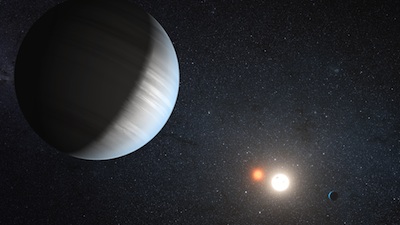Kepler Outreach Program

Four centuries after Johannes Kepler first described how planets orbit the Sun, NASA’s Kepler mission launches in search of Earth-size planets around distant stars.
Kepler will seek evidence of planets by observing more than 100,000 stars continuously, looking for the tiny dip in brightness caused by a planetary transit. I’m sure that Johannes would be amazed; I know that I am. The launch is scheduled from Cape Canaveral, Fla., at 10:49 p.m. EST on Friday, March 6. That’s tomorrow, and the countdown in underway. The excitement is palpable.
Kepler is the first spacecraft capable of discovering Earth-size planets in the habitable zone of distant stars. ESA’s CoRoT spacecraft is finding “super-Earths” which are planets several times the mass of Earth. CoRoT’s planets are in short period orbits, which means that the planets are close to their stars and are high temperature orbs. The latest CoRoT discovery is roughly twice the size of Earth. Ground-based telescopes search for exo-planets using spectroscopy, and have discovered a bounty of giant planets. More than 340 planets have been discovered, including 37 systems with multiple planets. Altogether, planets have been found orbiting more than 280 nearby stars. Amazing!
So far, planets as small as Earth have not been found. The Kepler mission is specifically designed to search for Earths in the habitable zone of other stars. This will take time. One transit is not sufficient. Discoveries must be confirmed by at least two additional transits, for a minimum of three transits. For a planet like Earth in orbit around a Sun-like star, the transits would be about a year apart. Thus, confirmation would require three years. The initial observation period for Kepler is 3.5 years, and it may be extended.
Bill Borucki, the Principal Investigator for the Kepler mission, has worked on the idea of finding Earths for more than 20 years. At first, he had to convince NASA that seeking small, terrestrial-type planets using the transit method was feasible. Could equipment be designed and launched that could actually accomplish the very precise observations needed to detect small planets? Borucki and his team proposed the Kepler mission four times to the Discovery Program. Following the third proposal in 1998, Dave Koch the Deputy Principal Investigator was granted research funds to build a CCD camera and Bill Borucki was granted funds to build a testbed. Together they formed the proof of concept. They built a physical simulator in the labs at NASA’s Ames Research Center and successfully demonstrated that the transit method could detect Earth-size planets. In the next round of Discovery proposals, two years later, the Kepler Mission made the first cut and was ultimately selected in December 2001 as the tenth Discovery mission. Today, a large team of scientists and engineers at NASA Ames Research Center, Jet Propulsion Laboratory, non-profit organizations (including the SETI Institute) and several universities are working together on Kepler, which was constructed by BATC (Ball Aerospace & Technologies Corporation) in Boulder, CO. (From Edna DeVore's Kepler Mission - Aiming at a New Earth)
